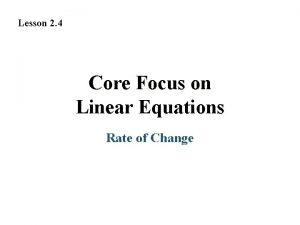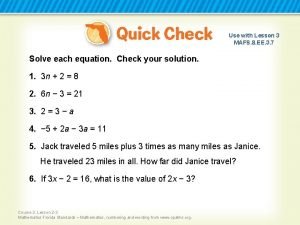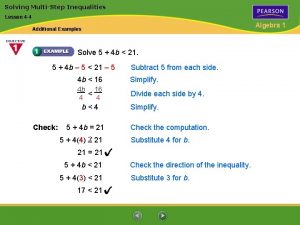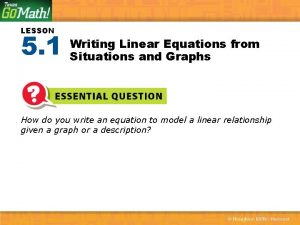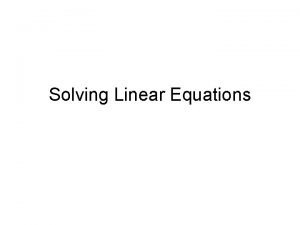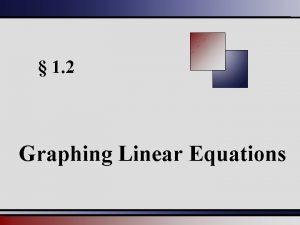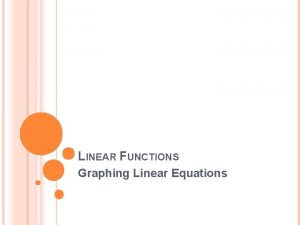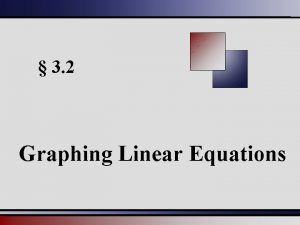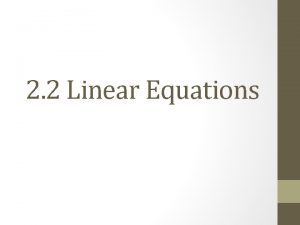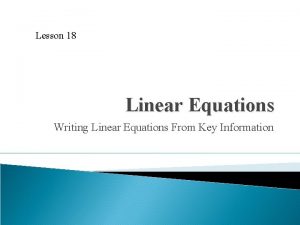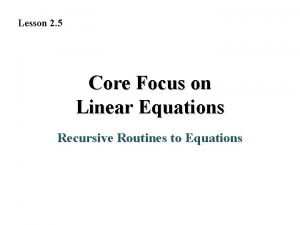Lesson 5 4 Core Focus on Linear Equations
















- Slides: 16

Lesson 5. 4 Core Focus on Linear Equations Q-Points and Lines of Best Fit

Warm-Up 1. Find the slope of the line through the points: a) (3, 15) and (7, 5) b) (– 1, 8) and (7, 24) 2 2. Write a slope-intercept equation for the line with: a) Point (6, 9) and slope = b) Point (5, – 4) and slope = – 2

Lesson 5. 4 Q-Points and Lines of Best Fit Write equations for a line of best fit based on Q-points.

Vocabulary Q-Points (Quartile Points) The points created by the intersection of the quartiles for the xand y-values in a data set.

Using Q-Points to Find a Line of Best Fit 1. Draw a scatter plot of the data set. 2. Find the five-number summary for the x-values. Draw vertical lines on the scatter plot at the Q 1 and Q 3 values. 3. Find the five-number summary for the y-values. Draw horizontal lines on the scatter plot at the Q 1 and Q 3 values. 4. Find the four intersection points created by the lines in parts 2 and 3. Write the ordered pairs of the two Q-points that follow the pattern of the data. 5. Write a slope-intercept form equation for the line that goes through the two Q-points.

Example 1 Mrs. Harvey’s PE class collected data about the effect of workout time on weight loss. Each student recorded how many hours they spent working out for a month. They also recorded how much weight they lost. Hours Spent Working Out 3 5 8 8 9 14 17 20 24 24 28 Number of Pounds Lost 2 3 3 6 5 6 7 9 8 10 10 Draw a scatter plot of the data. Number of Pounds Lost Use the Q-points of the data to find a line of best fit. Hours Spent Working Out

Example 1 Continued… Hours Spent Working Out 3 5 8 8 9 14 17 20 24 24 28 Number of Pounds Lost 2 3 3 6 5 6 7 9 8 10 10 Find the five-number summary of the hours spent working out (x-values). 3, 5, 8, 8, 9, 14, 17, 20, 24, 28 3 ~ 8 ~ 14 ~ 28 Number of Pounds Lost Use the Q-points of the data to find a line of best fit. Draw vertical lines at Q 1 = 8 and Q 3 = 24. Hours Spent Working Out

Example 1 Continued… Hours Spent Working Out 3 5 8 8 9 14 17 20 Number of Pounds Lost 2 3 3 6 5 6 7 9 24 A Q-point 24 may 28 not actually be a point 8 10 10 in the data set. Find the five-number summary of the y-values. Be sure to list the y-coordinates in order. 2, 3, 3, 5, 6, 6, 7, 8, 9, 10 2 ~ 3 ~ 6 ~ 9 ~ 10 Draw horizontal lines at Q 1 = 3 and Q 3 = 9. Number of Pounds Lost Use the Q-points of the data to find a line of best fit. From the four intersection points created by the lines, the points (8, 3) and (24, 9) follow the pattern of the data best. These are the two Q-points that lie on the line of best fit. Hours Spent Working Out

Example 1 Continued… Hours Spent Working Out 3 5 8 8 9 14 17 20 24 24 28 Number of Pounds Lost 2 3 3 6 5 6 7 9 8 10 10 Find the equation of the line through the two points. Write the equation in slope-intercept form: y = mx + b. Substitute one of the points (8, 3) into the equation to find the y-intercept, b. Number of Pounds Lost Use the Q-points of the data to find a line of best fit. Hours Spent Working Out The equation for the line of best fit based on Q-points is .

Explore! The Wave Your team has just scored the winning touchdown in the football game. The crowd goes wild and starts to do ‘the wave’ to celebrate the victory. How long will it take the wave to travel from one end of the stadium and back? Step 1 Have four students in the class line up to do the wave. A student at one end of the line throws his or her hands up and brings them back down. When the first student’s hands are up, the next student does the same, creating a ‘wave’ down the line. When the ‘wave’ reaches the end of the line, it should reverse back to the start of the line. Record the time it took to complete the wave to the nearest second. Step 2 Copy the table below. Continue to collect data for various numbers of students in the wave line. Each trial should have a different number of students. Collect eleven trials. Number of Students in Wave Time (Seconds) 4

Explore! The Wave Step 3 Let x represent the number of students in the wave. Let y represent the time in seconds. Plot the ordered pairs from the table on graph paper. Step 4 Find the five-number summary for the x-values and the y-values. Be sure each set of values is written in order before finding the five-number summary. Step 5 Draw vertical lines on the graph from Step 4 at the quartiles (Q 1 and Q 3) for the x-values. Draw horizontal lines on the graph at the quartiles for the yvalues. Step 6 Write the ordered pairs for the four Q-points created by the intersecting lines. Circle the two ordered pairs that best follow the pattern of the data. Step 7 Find the slope between the two points chosen in Step 6. Show to calculate the slope. Step 8 Substitute the slope and the coordinates of one of the two Q-points in the appropriate places in the equation: y = mx + b. Solve the equation for the y -intercept, b. Step 9 Write the final equation for the line in slope-intercept form. Check with a classmate. Do you have the same equation? If not, work together to determine the correct equation.

Explore! Finally, use the equation to make a prediction… Step 10 A stadium has 6 sections that stretch across one side. Each section has 30 seats per row. How many people could be seated in each row across the whole side of the stadium? Step 11 Substitute the answer from Step 10 into the Step 9 equation. Since this number represents the number of people in the ‘wave’, substitute it for x. Evaluate the expression to find the time, in seconds, to complete the ‘wave’ with this number of people. Is this the exact answer? Explain. The Wave

Example 2 Use the scatter plot to answer the questions. The vertical and horizontal lines based on the quartiles have already been drawn. a. Write the ordered pairs for the four Q-points created by the intersecting lines. The ordered pairs are (8, 16), (8, 7), (3, 7) and (3, 16). b. Does the graph show a positive or negative correlation? Which two Q-points follow the direction of the data best? Because the y-values decrease as x increases, this scatter plot shows a negative correlation. The two Q-points that follow the data best are (3, 16) and (8, 7).

Example 2 Continued… Use the scatter plot to answer the questions. The vertical and horizontal lines based on the quartiles have already been drawn. c. What is the slope of the line between those Q-points? d. Write an equation in slope-intercept form for the equation of the line through the Q-points. Slope-intercept form: Substitute the slope from part c. Substitute one of the points, (8, 7). Solve for b. Write the final equation.

Communication Prompt Do you think finding a line of best fit based on Q-points is always the best method? Explain.

Exit Problems Use the following data set for the problems below: x y 1 24 4 17 5 19 7 13 8 12 12 8 13 9 1. Make a scatter plot of the data. 2. Find the five-number summary for the x-values and the y-values. x: 1 ~ 4 ~ 7 ~ 12 ~ 13 y: 8 ~ 9 ~ 13 ~ 19 ~ 24 3. Draw in horizontal and vertical lines based on the quartiles. 4. What are the ordered pairs for the two Q-points that best follow the data? (4, 19) and (12, 9)
 Core focus on linear equations
Core focus on linear equations Core focus on linear equations
Core focus on linear equations Core focus on linear equations answer key
Core focus on linear equations answer key Whats initial value
Whats initial value Simultaneous equations linear and non linear
Simultaneous equations linear and non linear Difference between linear and non linear equations
Difference between linear and non linear equations Metode numerik sistem persamaan linear
Metode numerik sistem persamaan linear Focus on form vs focus on forms
Focus on form vs focus on forms Porter's generic strategies
Porter's generic strategies Timex cost leadership strategy
Timex cost leadership strategy Actor focus vs object focus
Actor focus vs object focus Unit 1 lesson 3 review of linear systems
Unit 1 lesson 3 review of linear systems Lesson 3 linear equations in x
Lesson 3 linear equations in x 5-3 solving multi-step inequalities
5-3 solving multi-step inequalities Lesson 4-2 absolute value inequalities
Lesson 4-2 absolute value inequalities 5-6 graphing inequalities in two variables
5-6 graphing inequalities in two variables Lesson 5-1 writing linear equations
Lesson 5-1 writing linear equations



